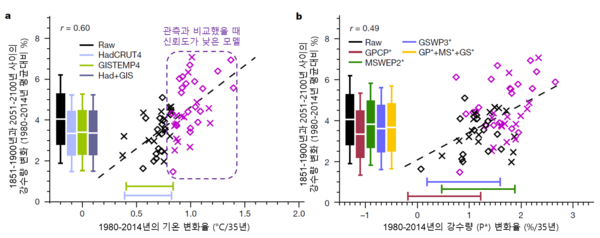Professor Hyungjun Kim, who is currently affiliated with both the KAIST Moon Soul Graduate School of Future Strategy and the Department of Civil and Environmental Engineering, has conducted international joint research with Tokyo University and Japan’s National Institute for Environmental Studies on improving the accuracy of the model for predicting changes in global precipitation. The joint research was able to successfully reduce the uncertainty in the prediction and the result was published in Nature on February 23 under the title “Emergent Constraints on Future Precipitation Changes”.
Minimizing uncertainty has always been a primary concern in the prediction of climate change as there are significant discrepancies in the predictions made from different climate models, such that data cannot be relied on to the full extent. The biggest impediment for the research in global mean precipitation change is that aerosols, which are air pollutants, in combination with greenhouse gases, may lead to ambiguous data interpretation. In the past, both greenhouse gas and aerosol levels have increased and their correlation has been used to anticipate the precipitation change. However, due to active prevention measures of air pollution in many countries, it is now expected that aerosol levels will decrease sharply while greenhouse gases will continue to increase, thus signifying that a new analysis method will be needed for more accurate predictions.

According to the theory of atmospheric energetics, the increase in temperature of the troposphere has led to an increase in longwave radiative cooling as well as precipitation due to latent heat increase, where the relationship between temperature and precipitation change is directly proportional. The research team has conducted studies using Coupled Model Intercomparison Project, a collaborative framework to investigate the general circulation models of coupled atmosphere-ocean, phase 5 (CHIMP5) and 6 (CHIMP6) and observed a high correlation (r = 0.83) between the projections of the global average change in precipitation and that of temperature.
However, the research team has also observed that the global mean emission of aerosol remained almost invariable in recent decades, which means that the conventional use of CHIMP5 and CHIMP6 would overestimate tropospheric warming, and thus produce less valid precipitation predictions. Assuming that the change in emission of aerosol was minimal, the team has found a significant correlation (r = 0.60) between prediction in precipitation change for 2051-2100 and previously measured trends in temperature change in 1980-2014.
Overall, the team was able to successfully reduce the uncertainty in the precipitation change model for the first time, from 6.2% to 5.2-5.7%, as well as reduce variance by 8-30%. Professor Kim claimed that he hopes to further contribute to the development of prediction in climate change with higher reliability as well as climate-related policies.

